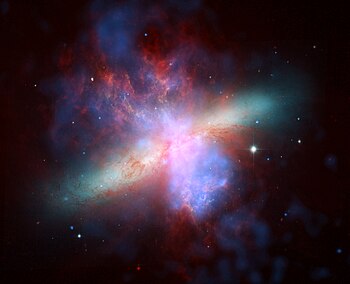Portal:Stars
IntroductionA star is a luminous spheroid of plasma held together by self-gravity. The nearest star to Earth is the Sun. Many other stars are visible to the naked eye at night; their immense distances from Earth make them appear as fixed points of light. The most prominent stars have been categorised into constellations and asterisms, and many of the brightest stars have proper names. Astronomers have assembled star catalogues that identify the known stars and provide standardized stellar designations. The observable universe contains an estimated 1022 to 1024 stars. Only about 4,000 of these stars are visible to the naked eye—all within the Milky Way galaxy. A star's life begins with the gravitational collapse of a gaseous nebula of material largely comprising hydrogen, helium, and trace heavier elements. Its total mass mainly determines its evolution and eventual fate. A star shines for most of its active life due to the thermonuclear fusion of hydrogen into helium in its core. This process releases energy that traverses the star's interior and radiates into outer space. At the end of a star's lifetime as a fusor, its core becomes a stellar remnant: a white dwarf, a neutron star, or—if it is sufficiently massive—a black hole. Stellar nucleosynthesis in stars or their remnants creates almost all naturally occurring chemical elements heavier than lithium. Stellar mass loss or supernova explosions return chemically enriched material to the interstellar medium. These elements are then recycled into new stars. Astronomers can determine stellar properties—including mass, age, metallicity (chemical composition), variability, distance, and motion through space—by carrying out observations of a star's apparent brightness, spectrum, and changes in its position in the sky over time. Stars can form orbital systems with other astronomical objects, as in planetary systems and star systems with two or more stars. When two such stars orbit closely, their gravitational interaction can significantly impact their evolution. Stars can form part of a much larger gravitationally bound structure, such as a star cluster or a galaxy. (Full article...) Selected star - Photo credit: Rutherfurd Observatory
Rigel, also known by its Bayer designation Beta Orionis (β Ori, β Orionis), is the brightest star in the constellation Orion and the seventh brightest star in the night sky, with visual magnitude 0.13. The star as seen from Earth is actually a triple star system, with the primary star (Rigel A) a blue-white supergiant of absolute magnitude −7.84 and around 120,000 times as luminous as the Sun. An Alpha Cygni variable, it pulsates periodically. Visible in small telescopes, Rigel B is itself a spectroscopic binary system, consisting of two main sequence blue-white stars of spectral type B9. If viewed from a distance of 1 astronomical unit, it would span an angular diameter of 35° and shine at magnitude −38. Like other blue supergiants, Rigel has exhausted burning its core hydrogen fuel and left the main sequence, expanding and brightening as it progresses across the Hertzsprung–Russell diagram. It will end its stellar life as a type II supernova, exploding and in the process flinging out material that will serve to seed future generations of stars. As it is both bright and moving through a region of nebulosity, Rigel lights up several dust clouds in its vicinity, most notably the IC 2118 (the Witch Head Nebula). Rigel is also associated with the Orion Nebula, which—while more or less along the same line of sight as the star—is almost twice as far away from Earth. Despite the difference in distance, projecting Rigel's path through space for its expected age brings it close to the nebula. As a result, Rigel is sometimes classified as an outlying member of the Orion OB1 Association, along with many of the other bright stars in that region of the sky. Selected article - Photo credit: JAXA/NASA
A solar flare is a large explosion in the Sun's atmosphere that can release as much as 6 × 1025 joules of energy. The term is also used to refer to similar phenomena in other stars, where the term stellar flare applies. Solar flares affect all layers of the solar atmosphere (photosphere, corona, and chromosphere), heating plasma to tens of millions of kelvins and accelerating electrons, protons, and heavier ions to near the speed of light. They produce radiation across the electromagnetic spectrum at all wavelengths, from radio waves to gamma rays. Most flares occur in active regions around sunspots, where intense magnetic fields penetrate the photosphere to link the corona to the solar interior. Flares are powered by the sudden (timescales of minutes to tens of minutes) release of magnetic energy stored in the corona. If a solar flare is exceptionally powerful, it can cause coronal mass ejections. X-rays and UV radiation emitted by solar flares can affect Earth's ionosphere and disrupt long-range radio communications. Direct radio emission at decimetric wavelengths may disturb operation of radars and other devices operating at these frequencies. Solar flares were first observed on the Sun by Richard Christopher Carrington and independently by Richard Hodgson in 1859 as localized visible brightenings of small areas within a sunspot group. Stellar flares have also been observed on a variety of other stars. The frequency of occurrence of solar flares varies, from several per day when the Sun is particularly "active" to less than one each week when the Sun is "quiet". Large flares are less frequent than smaller ones. Solar activity varies with an 11-year cycle (the solar cycle). At the peak of the cycle there are typically more sunspots on the Sun, and hence more solar flares. Selected image - Photo credit: NASA
Messier 82 (also known as NGC 3034, Cigar Galaxy or M82) is the prototypenearby starburst galaxy about 12 million light-years away in the constellation Ursa Major. The starburst galaxy is five times as bright as the whole Milky Way and one hundred times as bright as our galaxy's center. M82 was previously believed to be an irregular galaxy. However, in 2005, two symmetric spiral arms were discovered in the near-infrared (NIR) images of M82, and is now considered a spiral galaxy. Did you know?
SubcategoriesTo display all subcategories click on the ►
Selected biography - Photo credit: Eduard Ender
Tycho Brahe, born Tyge Ottesen Brahe (de Knudstrup) (14 December 1546 – 24 October 1601), was a Danish nobleman known for his accurate and comprehensive astronomical and planetary observations. Coming from Scania, then part of Denmark, now part of modern-day Sweden, Tycho was well known in his lifetime as an astronomer and alchemist. His Danish name "Tyge Ottesen Brahe" is pronounced in Modern Standard Danish as [ˈtsʰyːə ˈʌtəsn̩ ˈpʁɑːə]. He adopted the Latinized name "Tycho Brahe" (usually /ˈtaɪkoʊ ˈbrɑː/ or /ˈbrɑːhiː/ in English) from Tycho (sometimes written Tÿcho) at around age fifteen, and he is now generally referred to as "Tycho", as was common in Scandinavia in his time, rather than by his surname "Brahe". (The incorrect form of his name, Tycho de Brahe, appeared only much later. Tycho Brahe was granted an estate on the island of Hven and the funding to build the Uraniborg, an early research institute, where he built large astronomical instruments and took many careful measurements. After disagreements with the new king in 1597, he was invited by the Bohemian king and Holy Roman emperor Rudolph II to Prague, where he became the official imperial astronomer. He built the new observatory at Benátky nad Jizerou. Here, from 1600 until his death in 1601, he was assisted by Johannes Kepler. Kepler later used Tycho's astronomical information to develop his own theories of astronomy.
TopicsThings to do
Related portalsAssociated WikimediaThe following Wikimedia Foundation sister projects provide more on this subject:
Discover Wikipedia using portals |

























